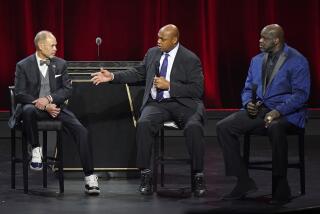Consumers want fewer TV channels and lower monthly bills - will ‘skinny’ packages work?
VH1 Classic, with music videos from the 1980s and ‘90s and movies like “The Breakfast Club,” was designed as a nostalgic stop for channel surfers.
Viacom Inc. launched the channel 15 years ago during the last big boom in cable programming. Back then consumers were hauling home high-definition big screens, and cable and satellite TV operators were eager to offer cutting-edge lineups with hundreds of channels.
Media companies laid claim to the channel space. Viacom figured it could milk its valuable MTV and Nickelodeon brands by creating offshoot channels such as Nicktoons, MTV Hits, MTV Jams and others. VH1 Classic was a hot ticket, featuring footage from old Led Zeppelin and Rolling Stones concerts and documentaries on the Beatles.
Stunning photos, celebrity homes: Get the free weekly Hot Property newsletter >>
But the world has changed.
American TV viewers receive an average 194 channels, and most people watch only about 17 — a number that has not budged despite the proliferation of networks, according to measurement firm Nielsen.
Networks such as VH1 Classic, Discovery Family, Esquire, ESPNu, Golf Channel and other sports outlets are part of a growing problem: too many little-watched channels that help ratchet up the cost of pay-TV packages. For some consumers, the bounty of channels represents waste.
“People don’t want massive amount of choice — particularly if they have to pay for it,” said Jeffrey Cole, director of the Center for the Digital Future at the USC Annenberg School for Communication and Journalism. “Most people hate the menu at the Cheesecake Factory because there are too many selections.”
Consumers have been demanding fewer TV channels and lower monthly bills. Those pleas were largely ignored until Internet streaming services Netflix and Hulu began attracting customers with low-cost plans with on-demand access to movies and TV shows. Consumers finally had options if they wanted to sever the cable cord.
Cable, satellite and other distributors collectively shed an estimated 625,000 pay-TV customers during the second quarter of this year, according to a report Thursday by consulting firm SNL Kagan. That followed an uncharacteristic dip when the industry posted a first-quarter net loss; the first in more than five years.
Cord-cutters aren’t the only problem. The industry is more fearful of a group they call “cord-nevers” — young consumers who move out of their parents’ homes and don’t sign up for a traditional pay-TV subscription.
“Changes are moving faster than a lot of people thought they would,” said David Kenny, chief executive of the Weather Co., which owns the Weather Channel. “It is all riding on the rails of technology.”
Breaking the bundle
Media executives recognize the need for reform, but have clung to the belief that an overwhelming majority of customers continues to be well served by big packages. Selling channels a la carte could ultimately cost consumers more, they say, because a much smaller pool of people would be subsidizing individual channels.
Breaking the bundle also would create a multibillion-dollar nightmare for media companies. Pay-TV packages provide the financial bedrock of the entertainment industry, generating $48 billion a year in programming fees.
But cracks are beginning to show. Wall Street this month dumped media stocks over fears that more consumers were cutting the cable cord.
The swift sell-off — which wiped out more than $50 billion in market value in just two days — started after Walt Disney Co. warned that profits from its juggernaut ESPN division would not be as robust as initial forecasts. Investors then sold shares of Time Warner, 21st Century Fox, Viacom, Comcast and Discovery, signaling that a high-stakes game of “survival of the fittest” is underway.
The largest programming companies have long leveraged their popular channels to strike advantageous deals with the pay-TV distributors.
Long-term programming contracts, for example, often stipulate that pay-TV distributors carry a company’s entire family of channels — or pay a higher price if they wanted to distribute only the most popular ones.
The transition is “going to be harder for the guys who have made so much money for so long off the bundle,” said Doug Creutz, media analyst with Cowen & Co.
Another reason for the foot-dragging: Major programming companies have had little incentive to purge channels because even those with skimpy ratings can be profitable.
VH1 Classic, for example, is available in 58 million homes and brings in an estimated $72 million in annual revenue, according to SNL Kagan. More than half of that is profit.
Costs are low. The company doesn’t spend much on programming because VH1 Classic showcases content from the MTV and VH1 vault, along with documentaries and old movies. VH1 Classic, and other tiny networks, can be managed by a skeleton staff with as few as 10 to 15 employees, according to one knowledgeable insider.
But ratings are minuscule. VH1 Classic doesn’t rank in the Top 100 television networks as measured by Nielsen.
Viacom isn’t the only company with also-ran networks. NBCUniversal has Esquire, Chiller, Oxygen and Sprout. Fox has such spin-offs as Nat Geo Wild and FXX. Discovery has American Heroes Channel and Velocity.
Time Warner, which has fewer channels, responded by offering HBO as a stand-alone streaming service. It also loaded up on sports rights to make TBS and TNT must-have channels.
Viacom contends that expensive sports networks are driving up package prices — and that dropping a few channels won’t solve the problem.
ESPN, for example, is sold for more than $6 a month per subscriber home, and in Southern California, SportsNet LA, which is owned by the Los Angeles Dodgers, is offered for an estimated $4.90 a month per subscriber home.
In contrast, most general entertainment channels are licensed for 10 cents to 50 cents a month per subscriber home, according to SNL Kagan.
“So long as the operators carry a broad array of sports networks, the cost of the TV package will remain high,” said Denise Denson, executive vice president for content distribution at Viacom Media Networks.
Going lean
Pay-TV companies recognize that they have to slim down the packages to keep customers who are increasingly consuming entertainment on mobile phones, tablets, laptops and game consoles. They have begun introducing “skinny” bundles, often offered in conjunction with a high-speed Internet subscription.
Analysts estimate that 2 million to 3 million TV homes — or about 2% to 3% of the total — have reduced the number of channels they receive or cut the cord entirely since 2012.
Dish Network this year launched Sling TV, an Internet streaming service that bypasses the company’s bread-and-butter delivery method of a satellite dish. Sling TV is aimed at the “cord-nevers” — the apartment dwellers, singles and young families who are interested in receiving only a few channels, including sports.
For $20-a-month, Sling’s “Best of Live TV” package includes Disney Channel, ESPN, ESPN2, Food Network, Cartoon Network and CNN. Customers can add HBO for an extra $15 a month and other add-on combinations. But Sling does not carry broadcast networks, including ABC and CBS, and it lacks some favorites, including Fox News Channel and Bravo.
Verizon’s skinny plan starts at $54.99 a month, a higher price tag because it includes the broadcast networks and more than a dozen cable channels. Subscribers can add additional “channel packs” for an extra $10 a month.
Tacking on several “channel packs” can quickly add up to roughly the same cost as a basic cable subscription, analysts have noted.
Verizon also is facing push-back. ESPN sued, contending its agreement prohibits Verizon from offering its channels in such a manner. Verizon disagrees.
Andy Albert, senior vice president of content acquisition for Cox Communications, which provides cable service on the Palos Verdes Peninsula and Orange County, said skinny bundles are a work in progress — and they might not satisfy most customers.
“In many ways, skinny bundles are still a myth,” Albert said. “The companies that advertise them are offering pretty fat bundles, and in some instances, they have omitted entire families of channels.... If you were to sit down and pick out all the channels that you wanted, and put them into some Franken-bundle, it would still add up to a pretty big number.”
RBC Capital Markets analyst David Bank ran the numbers and found the savings were not substantial. Consumers would save only about $29 a month by dropping traditional pay-TV and keeping a high-speed Internet service and a couple of streaming services, Bank said in a recent report.
There will likely be more carnage.
Independently owned channels — a group that includes Reelz Channel, arts channel Ovation, Outside TV, Fuse and AXS TV — could be vulnerable, analysts say. They lack the leverage of a big media company in contract negotiations — and thus might be easier for distributors to eliminate.
“There will be clear winners and losers,” said Bill Abbott, chief executive of the independent Crown Media Holdings, which owns the popular Hallmark Channel that is offered at a discount to some lower-rated channels. “We think we will continue to be a very attractive option,” Abbott said.
Todd Juenger, media analyst for Bernstein Research, has been monitoring the cord-cutting trend for several years. He said vestiges of the current system likely will linger.
“I think the pay-TV model is going to be like the land-line phone,” Juenger said. “While there has been steady erosion in the use of land lines, they have stuck around longer than most of us thought.”
MORE:
A ‘media meltdown’? Disney remark on TV viewing sends industry into tailspin
Media stocks falter on Disney warnings of lower cable profits
ABC chief Paul Lee talks about TV’s changing business model
More to Read
From the Oscars to the Emmys.
Get the Envelope newsletter for exclusive awards season coverage, behind-the-scenes stories from the Envelope podcast and columnist Glenn Whipp’s must-read analysis.
You may occasionally receive promotional content from the Los Angeles Times.







